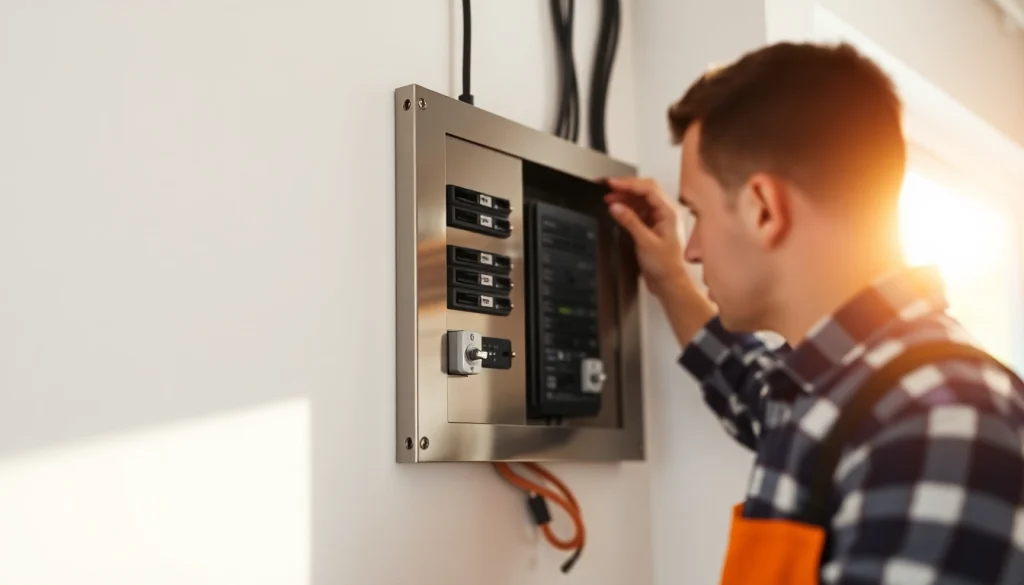Understanding the Electrical Panel: A Homeowner’s Guide
The Electrical Panel serves as the heart of your home’s electrical system. It distributes electricity to various circuits and protects the entire system from overloads and faults. Given its critical role, understanding its functions and maintenance is essential for every homeowner.
What is an Electrical Panel?
An electrical panel, often referred to as a breaker panel, circuit breaker box, or distribution board, is a metal box that houses your home’s electrical circuits. It connects the main incoming electrical supply to a series of breakers, each controlling a specific circuit in the home. This panel not only directs the electrical flow but also acts as a safety device that interrupts electrical currents during situations of overload or short circuits. The panel transforms incoming electricity from your utility provider into usable forms for your home’s appliances and electronics.
Components of an Electrical Panel
Understanding the components of an electrical panel can help homeowners appreciate its importance and maintenance needs. Key components include:
- Main Breaker: The large switch that controls the power flowing to the entire home.
- Branch Circuits: Smaller switches (or circuit breakers) that control electricity to specific areas or appliances.
- Neutral Bar: A metal bar that connects all neutral wires from each circuit, allowing the return current to flow safely.
- Grounding Bar: Similar to the neutral bar, but it provides a path for electrical surges and faults to prevent shock hazards.
- Bus Bars: Conductors that distribute electricity from the main breaker to the branch circuits.
The Importance of an Efficient Electrical Panel
An efficient electrical panel ensures safety and optimal performance of a home’s electrical system. It balances electrical loads, prevents overheating, and minimizes the risk of electrical fires. Modern panels are designed to handle higher loads, which is especially crucial as more electronic devices and appliances are introduced into our homes. Failure to maintain or upgrade your electrical panel can lead to frequent tripping of circuit breakers, potential electrical fires, and hazards caused by outdated or malfunctioning equipment.
Signs It’s Time to Upgrade Your Electrical Panel
Recognizing the signs that indicate the need for an electrical panel upgrade is crucial for maintaining safety and efficiency within your home. Here are some key indicators:
Frequent Circuit Breaker Trips
One of the most common signs of an overloaded panel is frequent tripping of circuit breakers. If you find yourself resetting breakers regularly, it may be time to upgrade your electrical panel. Frequent tripping occurs when the demand for power exceeds the panel’s capacity, which can lead to overheating and other electrical hazards.
Outdated Panel Models
If your electrical panel is more than 20 years old, it may not meet current safety standards or accommodate the increasing electrical demands of modern households. Outdated panels may lack essential features such as surge protection and overcurrent detection, leaving your home vulnerable to electrical faults.
Increased Electrical Demand
With the proliferation of smart home devices, large appliances, and high-energy-demand gadgets, many households find themselves requiring more power than their existing panels can provide. If you notice that you’re constantly overloading circuits when using multiple devices, it’s essential to assess whether your panel can meet these demands.
Choosing the Right Electrical Panel for Your Home
Selecting the right electrical panel for your home involves understanding different types, amperage needs, and essential features that can enhance performance.
Types of Electrical Panels
When choosing an electrical panel, homeowners have several options based on their needs:
- Main Breaker Panel: Commonly used in residential properties. It includes a main breaker and several branch breakers.
- Subpanel: A smaller panel that can extend the number of circuits in larger homes or serve as a dedicated panel for certain areas like a garage or workshop.
- Transfer Switch Panels: Used for homes with generators, ensuring seamless switching between grid energy and generator power during outages.
Understanding Amperage Needs
The amperage rating of your electrical panel determines how much electricity can safely flow through it. Common amperage ratings are:
- 100 Amps: Suitable for smaller homes with basic electrical needs.
- 200 Amps: The standard for most modern homes equipped with multiple electronics and appliances.
- 400 Amps: Designed for larger homes or those with heavy electrical use, such as multiple HVAC systems.
Key Features to Look For
When selecting an electrical panel, consider features such as:
- Space for Future Upgrades: Choose a panel with additional slots for circuit breakers to accommodate future electrical demands.
- Surge Protection: Integrated or separate surge protectors can safeguard your home from power surges caused by external factors like lightning.
- Smart Technology Integration: Some modern panels offer smart technology capabilities, allowing you to monitor usage and receive alerts through mobile devices.
The Electrical Panel Upgrade Process
Upgrading an electrical panel involves a careful assessment, planning, and execution to ensure safety and compliance with local codes.
Initial Assessments and Planning
Before any upgrade, a qualified electrician should conduct an assessment of your current panel, wiring, and overall electrical system. This evaluation will determine the correct amperage needed for your home, potential code requirements, and whether additional wiring is necessary. Planning may also include obtaining permits if required by local regulations.
Installation Steps Explained
- Power Shutdown: The first step in the installation process is to shut off power from the main electrical supply.
- Removing the Old Panel: The electrician will remove the existing panel, disconnecting all wires carefully.
- Wiring the New Panel: The new panel is wired in accordance with local electrical codes. This may require re-routing wiring for improved efficiency.
- Testing Connections: Once everything is installed, connections are tested to ensure safety and performance before the final power-up.
- Power Restoration and Verification: After thorough testing, power is restored, and the newly installed panel is monitored for a short period to confirm proper functionality.
Post-Installation Best Practices
After upgrading your electrical panel, adopting several best practices can ensure its longevity and efficiency:
- Regular Inspections: Schedule routine inspections with a qualified electrician to identify any potential issues early.
- Keep it Clean: Ensure the panel remains free of dust and debris, which can contribute to overheating.
- Label Circuits: Clearly label each circuit breaker in the panel for quick identification should issues arise in the future.
Maintaining Your Electrical Panel for Longevity
To ensure the longevity and efficiency of your electrical panel, regular maintenance and timely troubleshooting are essential.
Routine Inspections
Homeowners should engage professionals for routine inspections, ideally every 3-5 years. Inspections should include checks for rust, loose connections, or any signs of overheating. Upgrades to circuit breakers and components should also be considered during these inspections based on your evolving electrical needs.
Troubleshooting Common Issues
Common issues with electrical panels include:
- Flickering Lights: Often results from loose wiring or equipment drawing excess power. An electrician can inspect circuits to find the root cause.
- Burning Smell or Heat: If you notice any burning smells or excessive heat from the panel, turn off the main power and contact a professional immediately.
- Obsolete Breakers: Regularly check that circuit breakers are not outdated, which could increase risks.
When to Call a Professional
If you experience recurring electrical issues, such as frequent tripping of breakers or if you’ve made significant renovations to your home, it is imperative to contact a licensed electrician. Attempting upgrades or repairs without proper knowledge can be both dangerous and costly.
In conclusion, understanding and maintaining your electrical panel is essential for the safety and efficiency of your home’s electrical system. Upgrading your panel can not only accommodate modern electrical demands but also enhance the safety of your home, protecting both your investments and your family. Whether you are facing frequent breaker trips or planning for future electrical needs, a comprehensive approach to managing your electrical panel will ensure your home remains a safe haven.



